Posted on September 20, 2015
Standing for the Ancestors in Santa Cruz, 80 strong
Saturday morning, we stood together with over 80 people of all ages, forming a giant circle at the very place where Mission Santa Cruz once towered over this land. All spoke aloud in turn their reasons for being there. “To offer my deepest respects and my blessings to the walkers who have undertaken this courageous journey,” one woman said. “To acknowledge and grieve the suffering of the indigenous ancestors of this land, and learn the true stories of what happened here,” said another.
“In honor of my Cahuilla ancestors, who worked at Mission San Gabriel during the dark period of genocide.” said Valerie Jean Chase. “On behalf of my father, whose life was also so impacted by the Church,” voiced Theo Wilson, a Pit River Tribe descendant. “In support of my children, the next generation learning the truth. In teaching my children to care for the land, I want them to learn about the people who really cared for the land, and what happened to them,” said wilderness skills instructor Naali Aelfgifu.
After the circle of introductions and smudging, all were asked to respectfully and quietly follow Caroline, walking over to the large asphalt parking lot adjacent to the Holy Cross Church, where we again formed a large circle. Beneath the parking lot lies the burial ground of untold numbers of indigenous people who perished in Mission times. After leading a prayer and a moment of silence for the ancestors, Caroline shared some reflections from the journey in progress.
“The parking lot we’re standing on now is the ancestors’ burial site. With not even so much as a marker. It’s been like that at every Mission we’ve been to, and at each one it gets harder and harder to hear how many of the indigenous people of this land have been disrespected. Forgotten about, except for by their own people, and the people who stand in solidarity,” Caroline Ward Holland told the group.
“Kagen and I have heard messages as we walk, and we look at each other at the same time, and say, this is not only about the canonization of Junipero Serra. That’s the last thing on our mind. First and foremost, this is to honor all the ancestors, of all the Indigeous people who were here before European contact. But in the same breath, it has brought together such wonderful people who are standing in solidarity, and our relations with other California tribes have strengthened. So, it’s not just tribe after tribe fighting for the same things: by the time we get to San Diego, it’ll be all the tribes, as one nation, fighting for the same thing. And that is Respect, for the people that have been here, for the ground that we all walk on.”
Local indigenous solidarity organizer Cat Wilder spoke about restoring lands to the local tribes. “Who owns this land now, that we’re standing on? The Catholic Church. And what do Ohlone people own in Santa Cruz County today? Nothing! This isn’t just a history. It’s an ongoing legacy of genocide and colonialism in which the indigenous people continue to have no land, they continue to suffer from the traumas the church brought here, and then later on, what the United States and the Gold Rush brought here.
“…If the Church wanted to take true steps towards reconciliation, towards justice, they could start with reversing the canonization of Junipero Serra. They could start with the other long-standing demand of indigenous leaders, to rescind the Doctrine of Discovery. Then, what they could do, is actually direct Church resources towards giving the indigenous peoples lands back, lands that they stole centuries ago. The Church owns so much land throughout California, and most tribes within the Mission belt are federally unrecognized and continue to be landless. The Church could also be funding indigenous-led cultural revitalization efforts such as reclaiming traditional spiritual practices and reviving the indigenous languages that Missionaries prevented from being spoken. They could fund health services for unrecognized California Indians, who are still experiencing intergenerational trauma from the Mission times. If they really cared, that would be a start.”
After the prayer circle in the parking lot, we returned to the grass plaza. Martin Rizzo, a PhD candidate at UCSC whose dissertation focuses on the history of the tribes and individuals impacted by the Missions of Ohlone territory, gave an insightful 20-minute talk about the history of Mission Santa Cruz. He encouraged us to remember the courage and perseverance of those who survived as well as those who sacrificed, emphasizing little-known stories of the resistance and resilience.
Holy Cross Church was built in 1889 adjacent to the site of old Mission Santa Cruz, which had collapsed in an earthquake. The Church was built right over part of the mass burial ground where thousands of ancestors bodies were interred “three layers deep” or more. The Missionaries own records indicate 2,078 Indians were buried at Santa Cruz by the year 1840. When the foundation for Holy Cross Church was being dug and cleared, Church officials chose to disinter the forgotten dead, Indian and Californio alike:
“The more they dug and leveled, the more graves that were unearthed. So it was decided to remove the remnants of the dead and rebury them out at Holy Cross Cemetery. Over the next couple of weeks, six wagon loads of remains, including bones, clothing bits and broken pieces of tombstones were taken over to the cemetery and buried in a huge common grave. All the contents of the graves were hopelessly mixed together so that individual identification was virtually impossible.” [source]
Our walk left the Mission grounds at 11am with 25 people, including a baby in a stroller. After stopping briefly at Barrios Unidos, where we’d been invited to share the message of the walk with the participants of a community festival that was taking place there, we made our way to the entrance gate of the Holy Cross Cemetery on Capitola Rd Extension. After a tobacco offering, our procession wound past the hundreds of headstones to a large patch of drought-parched grass in the back of the property. Here, marked by little orange stakes in the ground, is the mass grave containing the hundreds of remains that were removed for the construction of Holy Cross Church.
This mass-grave has stood completely unmarked—just a big open patch of grass—for over a century. Only in the past year, a local neighborhood group that learned of this history joined together and decided to create a grave marker. Currently, a temporary marker consists of a metal stake in the ground with a laminated card attached. The card reads “Native American Mass Grave Marker. Do Not Remove.”
Temperatures were sweltering in the sunlight, however, the group of walkers determinedly made their way down the length of Soquel Avenue and along Valencia Road, stopping for the night at a farm in the Aptos countryside. This morning—Sunday—we continued our journey, and presently are on the way to Mission San Juan Bautista, where we will be joined by Mutsun Ohlone descendant Ann Marie Sayers, and all others who come to stand with us.

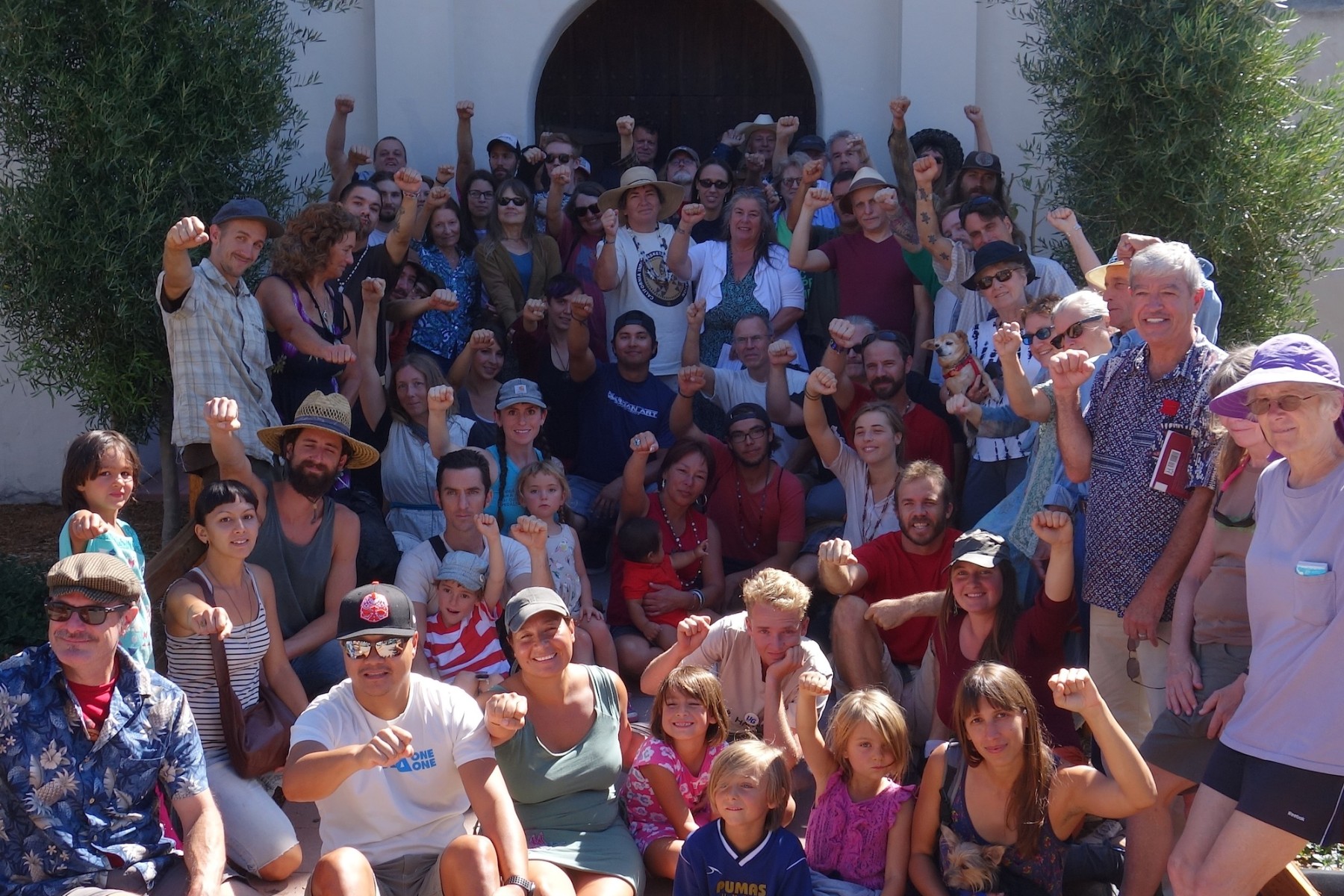

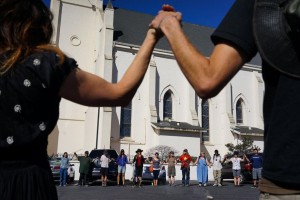

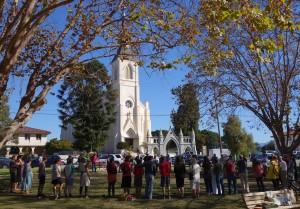
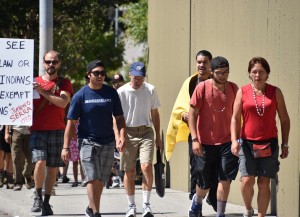
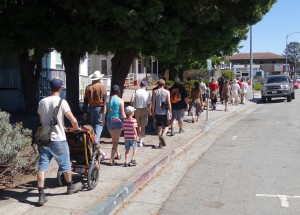
Thank you to all of walkers, and all those who came out, for there dedication!